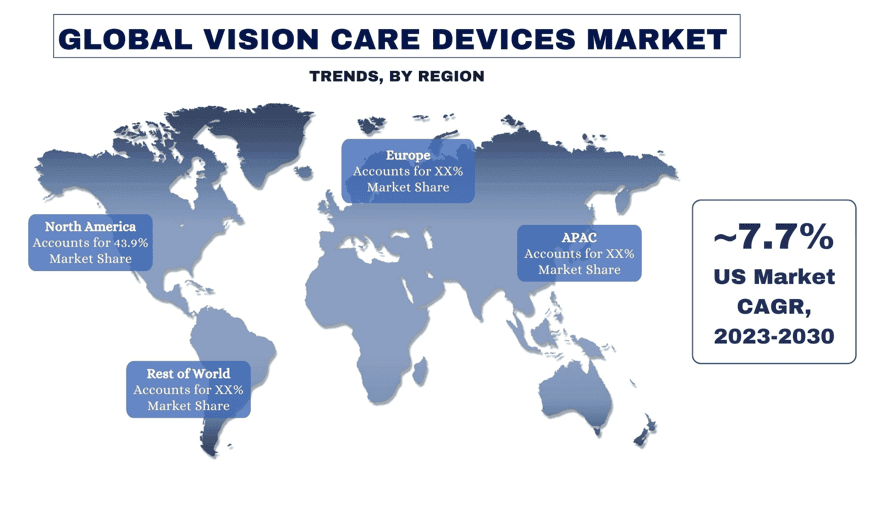- Home
- About Us
- Industry
- Services
- Reading
- Contact Us
Vision Care Devices Market: Current Analysis and Forecast (2023-2030)
Emphasis on Type (Intraocular Lens, Glaucoma Drainage Devices, Contact Lenses, Ophthalmic Lasers, and Others); Application (Surgeries, Diagnosis, and Eye Care); End-User (Hospitals, Optical Centers, and Others); Region/Country.
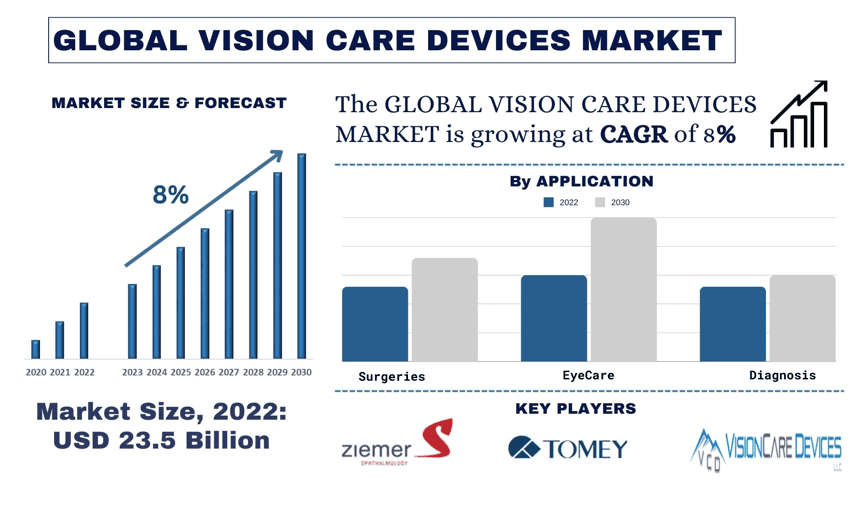
Vision Care Devices Market Size & Forecast
The vision care devices market was valued at USD 23547.77 Million in 2022 and is expected to grow at a strong CAGR of around 8% during the forecast period (2023-2030) owing rising prevalence of limb loss.
Vision Care Devices Market Analysis
The vision care devices market encompasses a wide range of products and services aimed at addressing various vision-related issues. This market includes eyeglasses, contact lenses, refractive surgery, and other vision enhancement technologies.
According to the National Eye Institute, by 2050, nearly 5.5 million Americans are projected to have severe vision impairment due to age-related macular degeneration alone.
According to Eurostat, the statistical office of the European Union, in 2021, over 20% of the EU population was aged 65 or older [EU Elderly population statistics]. This number is projected to rise to nearly 30% by 2050. As people age, their risk of developing vision problems like cataracts and macular degeneration increases significantly. This growing elderly population creates a substantial demand for vision correction devices and surgical procedures, fueling market expansion.
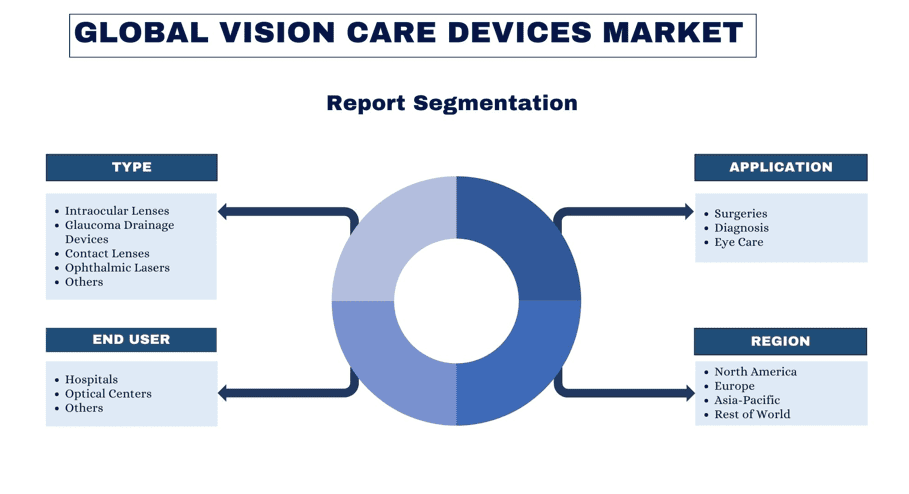
Vision Care Devices Market Trends
This section discusses the key market trends that are influencing the various segments of the Vision Care Devices Market as identified by our team of research experts.
Glaucoma Drainage Devices Transforming Industry
Glaucoma drainage devices are used to drain and divert humor that is caused by glaucoma, which can cause serious damage to the eye if not treated properly. The 2022 update from the World Glaucoma Association (WGA) reveals that approximately 79.6 million individuals globally were anticipated to have glaucoma in 2020. This number is expected to rise to 111.8 million by 2040. The WGA also highlighted that at least 50% of glaucoma patients remain unaware of their condition. In some developing countries, as much as 90% of glaucoma cases go undetected. Furthermore, the increasing prevalence of glaucoma is linked to the growth in glaucoma surgery, which is projected to contribute to the expansion of glaucoma drainage devices in the forecast period. In addition to this, rising company investment is also driving the segmental growth. For instance:
In July 2023, Myra Vision has started its initial human clinical trial of the Calibreye System, a glaucoma drainage device that features adjustable outflow control. This system is specifically designed to effectively lower intraocular pressure (IOP) for patients with moderate to severe glaucoma. The study, a prospective open-label feasibility trial, is non-randomized and aims to assess the clinical procedure, safety, and overall effectiveness of the Calibreye System in open-angle glaucoma patients.
In February 2022, Santen Pharmaceutical Co., Ltd. received approval to market the PRESERFLO MicroShunt Glaucoma Drainage System Core Kit, an intraocular drainage device.
In May 2021, Glaukos Corporation and Santen Pharmaceutical Co., Ltd. signed a new agreement for the development and commercialization of the PRESERFLO™ MicroShunt. Glaukos Corporation now holds exclusive commercialization rights for the MicroShunt in various countries, including the United States, Australia, and Latin America.
In April 2020, Allergan Plc., now part of AbbVie Inc., obtained product approval from China’s NMPA for the XEN Gel Stent for treating refractory glaucoma patients through the Real World Evidence pathway.
Asia Pacific is Expected to Grow With Significant CAGR During Forecast Period
Asia Pacific region is anticipated to grow with a high CAGR during the forthcoming period. The Asia Pacific vision care devices market is experiencing a boom, driven by several key factors. According to a report by the Indian government think-tank NITI Aayog, the region’s aging population is a major driver. By 2050, it’s projected that one in four Asians will be over 60 years old, significantly increasing the demand for corrective lenses and cataract surgeries. This is compounded by rising disposable incomes and growing awareness of eye health, leading to increased spending on vision correction solutions. Technological advancements are another key factor.
Companies like Alcon, a leading vision care company, announced FDA approval for their next-generation LenSx cataract laser system in 2023. This reflects a trend of innovation in the industry, offering patients minimally invasive and more precise procedures. These factors combine to make the Asia Pacific region a leader in vision care device market growth.
Vision Care Devices Industry Overview
The vision care devices market is competitive and fragmented, with the presence of several global and international market players. The key players are adopting different growth strategies to enhance their market presence, such as partnerships, agreements, collaborations, new product launches, geographical expansions, and mergers and acquisitions. Some of the major players operating in the market are Johnson & Johnson; EssilorLuxottica; NIDEK CO., LTD; Ziemer Ophthalmic Systems AG; Bausch + Lomb; ZEISS Group; Tomey Corporation; Alcon; CooperVision, and VisionCare Devices.
Vision Care Devices Market News
- In February 2022, Santen Pharmaceutical Co., Ltd. received approval to market the PRESERFLO MicroShunt Glaucoma Drainage System Core Kit, an intraocular drainage device.
- In November 2021, Alcon, Inc. announced its intention to acquire Ivantis, a company that develops and manufactures minimally invasive surgery devices for glaucoma. The intended acquisition affirms Alcon’s commitment to further strengthen its industry-leading portfolio across refractive, retina, cataract, and glaucoma.
- In July 2021, Carl Zeiss Meditec AG announced the launch of its new ZEISS medical ecosystem. The company aims to introduce a fully integrated environment, which is technologically advanced, wherein a combination of devices, applications, data management, and services propel constant improvement of patient outcomes.
Vision Care Devices Market Report Coverage
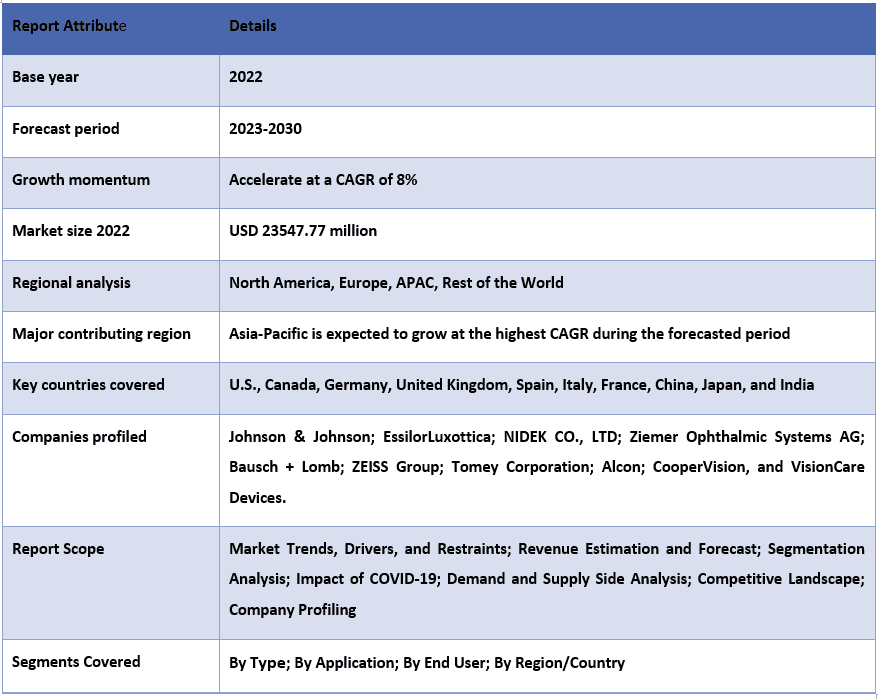
Reasons to buy this report:
- The study includes market sizing and forecasting analysis validated by authenticated key industry experts.
- The report presents a quick review of overall industry performance at one glance.
- The report covers an in-depth analysis of prominent industry peers with a primary focus on key business financials, product portfolios, expansion strategies, and recent developments.
- Detailed examination of drivers, restraints, key trends, and opportunities prevailing in the industry.
- The study comprehensively covers the market across different segments.
- Deep dive regional level analysis of the industry.
Customization Options:
The global vision care devices market can further be customized as per the requirement or any other market segment. Besides this, UMI understands that you may have your own business needs, hence feel free to connect with us to get a report that completely suits your requirements.
Table of Content
Research Methodology for the Vision Care Devices Market Analysis (2023-2030)
Analyzing the historical market, estimating the current market, and forecasting the future market of the global vision care devices market were the three major steps undertaken to create and analyze the adoption of vision care devices in major regions globally. Exhaustive secondary research was conducted to collect the historical market numbers and estimate the current market size. Secondly, to validate these insights, numerous findings and assumptions were taken into consideration. Moreover, exhaustive primary interviews were also conducted, with industry experts across the value chain of the global vision care devices market. Post assumption and validation of market numbers through primary interviews, we employed a top-down/bottom-up approach to forecasting the complete market size. Thereafter, market breakdown and data triangulation methods were adopted to estimate and analyze the market size of segments and sub-segments of the industry pertains to. Detailed methodology is explained below:
Analysis of Historical Market Size
Step 1: In-Depth Study of Secondary Sources:
Detail secondary study was conducted to obtain the historical market size of the vision care devices market through company internal sources such as annual reports & financial statements, performance presentations, press releases, etc., and external sources including journals, news & articles, government publications, competitor publications, sector reports, third-party database, and other credible publications.
Step 2: Market Segmentation:
After obtaining the historical market size of the vision care devices market, we conducted a detailed secondary analysis to gather historical market insights and share for different segments & sub-segments for major regions. Major segments are included in the report as type, application, and end-user. Further country-level analyses were conducted to evaluate the overall adoption of testing models in that region.
Step 3: Factor Analysis:
After acquiring the historical market size of different segments and sub-segments, we conducted a detailed factor analysis to estimate the current market size of the vision care devices market. Further, we conducted factor analysis using dependent and independent variables such as type, application, and end-user of the vision care devices market. A thorough analysis was conducted for demand and supply-side scenarios considering top partnerships, mergers and acquisitions, business expansion, and product launches in the vision care devices market sector across the globe.
Current Market Size Estimate & Forecast
Current Market Sizing: Based on actionable insights from the above 3 steps, we arrived at the current market size, key players in the global vision care devices market, and market shares of the segments. All the required percentage shares split, and market breakdowns were determined using the above-mentioned secondary approach and were verified through primary interviews.
Estimation & Forecasting: For market estimation and forecast, weights were assigned to different factors including drivers & trends, restraints, and opportunities available for the stakeholders. After analyzing these factors, relevant forecasting techniques i.e., the top-down/bottom-up approach were applied to arrive at the market forecast for 2030 for different segments and sub-segments across the major markets globally. The research methodology adopted to estimate the market size encompasses:
- The industry’s market size, in terms of revenue (USD) and the adoption rate of the vision care devices market across the major markets domestically
- All percentage shares, splits, and breakdowns of market segments and sub-segments
- Key players in the global vision care devices market in terms of products offered. Also, the growth strategies adopted by these players to compete in the fast-growing market
Market Size and Share Validation
Primary Research: In-depth interviews were conducted with the Key Opinion Leaders (KOLs) including Top Level Executives (CXO/VPs, Sales Head, Marketing Head, Operational Head, Regional Head, Country Head, etc.) across major regions. Primary research findings were then summarized, and statistical analysis was performed to prove the stated hypothesis. Inputs from primary research were consolidated with secondary findings, hence turning information into actionable insights.
Split of Primary Participants in Different Regions
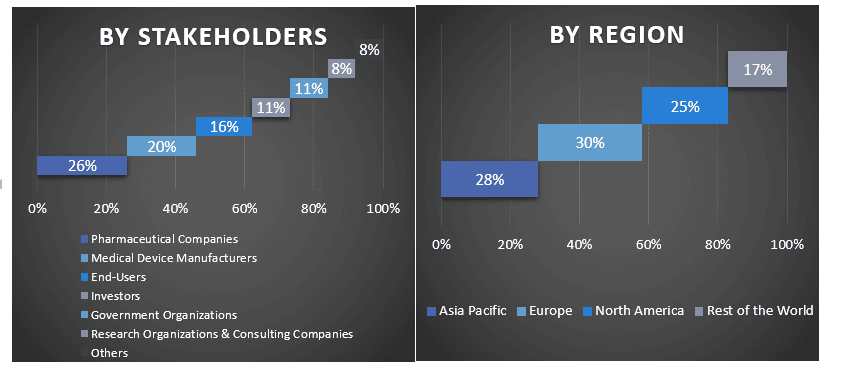
Market Engineering
The data triangulation technique was employed to complete the overall market estimation and to arrive at precise statistical numbers for each segment and sub-segment of the global vision care devices market. data was split into several segments & sub-segments post studying various parameters and trends in the areas of the type, application, and end-user in the global vision care devices market.
The main objective of the Global Vision Care Devices Market Study
The current & future market trends of the global vision care devices market were pinpointed in the study. Investors can gain strategic insights to base their discretion for investments on the qualitative and quantitative analysis performed in the study. Current and future market trends determined the overall attractiveness of the market at a regional level, providing a platform for the industrial participant to exploit the untapped market to benefit from a first-mover advantage. Other quantitative goals of the studies include:
- Analyze the current and forecast market size of the vision care devices market in terms of value (USD). Also, analyze the current and forecast market size of different segments and sub-segments
- Segments in the study include areas of the type, application, and end-user
- Define and analysis of the regulatory framework for the vision care devices industry
- Analyze the value chain involved with the presence of various intermediaries, along with analyzing customer and competitor behaviors of the industry
- Analyze the current and forecast market size of the vision care devices market for the major region
- Major countries of regions studied in the report include Asia Pacific, Europe, North America, and the Rest of the World
- Company profiles of the vision care devices market and the growth strategies adopted by the market players to sustain in the fast-growing market
- Deep dive regional level analysis of the industry
Frequently Asked Questions FAQs
Q1: What is the current market size and growth potential of the vision care devices market?
Q2: What are the driving factors for the growth of the vision care devices market?
Q3: Which segment has the largest share of the vision care devices market by type?
Q4: What are the emerging technologies and trends in the vision care devices market?
Q5: Which region will dominate the vision care devices market?
Related Reports
Customers who bought this item also bought

